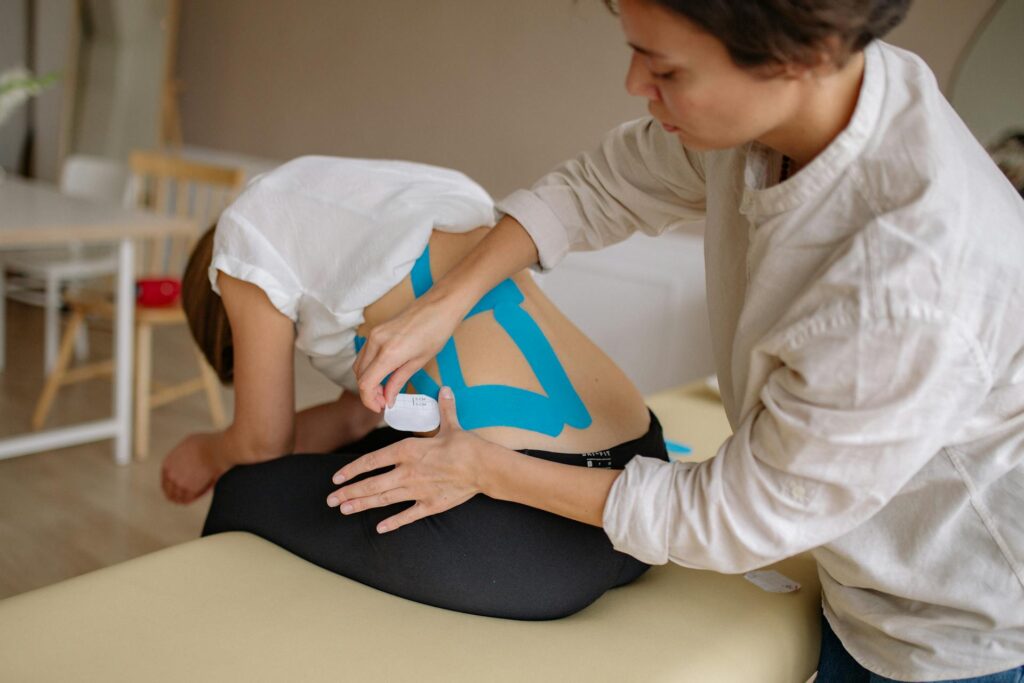Does Kinesiology Tape Really Work?

Does Kinesiology Tape Really Work? A Vaughan Physiotherapy Perspective
You’ve probably seen athletes at the Vaughan Sportsplex or local gyms sporting colorful strips of tape on their shoulders, knees, or backs. Kinesiology tape has become a popular tool in sports medicine and rehabilitation, but does it actually work? As experts in physiotherapy in Vaughan, we get this question all the time from patients recovering from injuries or looking to enhance performance.
The short answer? Yes—when used correctly. But there’s more to it than slapping on some stretchy tape and hoping for the best. Let’s break down how kinesiology tape works, when it’s most effective, and why many Vaughan residents are incorporating it into their recovery plans with guidance from physiotherapists.
What Is Kinesiology Tape?
Unlike traditional athletic tape that immobilizes joints, kinesiology tape is designed to:
- Support muscles without restricting movement
- Improve circulation and reduce swelling
- Enhance proprioception (your body’s awareness of movement)
Developed in the 1970s by a Japanese chiropractor, the tape gained global attention during the 2008 Olympics when volleyball players and other athletes wore it prominently. Today, it’s a staple in many physiotherapy clinics in Vaughan, including ours at PhysioChiroWellness.
How Kinesiology Tape Works: The Science Behind the Stretch
1. Pain Relief Mechanism
The tape lifts the skin slightly, creating space between the skin and underlying tissues. This:
- Reduces pressure on pain receptors
- Allows better lymphatic drainage to decrease swelling
- May trigger the body’s natural pain-relieving responses
A study published in the Journal of Orthopaedic & Sports Physical Therapy found that kinesiology tape provided short-term pain relief for patients with shoulder impingement.
2. Muscle Support & Performance
When applied along a muscle’s length, the tape:
- Provides gentle support during movement
- May reduce muscle fatigue during prolonged activity
- Helps maintain proper alignment
Vaughan runners and weekend warriors often use it for races or tournaments under their physiotherapist’s guidance.
3. Swelling Reduction
The unique wave-pattern adhesive creates channels that:
- Improve lymphatic flow
- Reduce post-injury or post-surgical edema
This makes it particularly useful after ankle sprains—a common complaint at our Vaughan physiotherapy clinic.
Conditions That May Benefit From Kinesiology Taping
1. Rotator Cuff Injuries
Properly applied tape can offload strained shoulder muscles while allowing functional movement.
2. Knee Pain (Patellofemoral Syndrome)
Taping techniques can help realign the kneecap and reduce grinding sensations.
3. Lower Back Strain
Many of our Vaughan office workers find relief from posture-related back pain with strategic taping.
4. Pregnancy-Related Pelvic Pain
Specialized taping methods support the abdomen and pelvis without restricting movement.
What the Research Says
While more studies are needed, current evidence suggests:
- Canadian Physiotherapy Association acknowledges its benefits for certain musculoskeletal conditions
- Health Canada regulates kinesiology tape as a Class I medical device
- Best results occur when combined with other physiotherapy in Vaughan treatments like exercise and manual therapy
Common Myths About Kinesiology Tape
Myth 1: It Works Like a Brace
Unlike rigid supports, the tape enhances—rather than replaces—your body’s natural movement patterns.
Myth 2: Any Application Will Do
Improper taping can be ineffective or even harmful. Our Vaughan physiotherapists assess each patient’s needs before application.
Myth 3: The Brand Doesn’t Matter
Quality varies significantly. We use medical-grade tape that maintains its adhesive properties through sweat and movement.
How Our Vaughan Physiotherapy Clinic Uses Kinesiology Tape
At PhysioChiroWellness, we incorporate taping as part of comprehensive treatment plans that may include:
- Initial Assessment
- Identifying the root cause of your pain or dysfunction
- Determining if taping is appropriate for your condition
- Custom Application
- Precise placement based on your anatomy and goals
- Demonstration of how to apply it yourself when needed
- Combination Therapies
- Pairing with therapeutic exercises for long-term results
- Integrating with chiropractic adjustments when appropriate
Who Should (and Shouldn’t) Use Kinesiology Tape
Good Candidates Include:
- Athletes looking for performance support
- Desk workers with postural strain
- Post-surgical patients (with clinician approval)
- Seniors managing arthritis pain
Caution Needed For:
- People with skin sensitivities or open wounds
- Certain circulatory conditions
- Acute injuries requiring immobilization
Try It Yourself (With Professional Guidance)
While DIY kits are available, we recommend:
- Getting properly assessed first
- Learning correct application from a physiotherapist in Vaughan
- Starting with shorter wear times (2-3 days maximum initially)
Experience the Difference at Our Vaughan Clinic
What sets our approach apart?
- Evidence-based techniques tailored to your specific needs
- Combination therapies that address the root cause of pain
- Education on proper use and complementary exercises
Ready to See if Kinesiology Tape With Physiotherapy in Vaughan Can Help You?
Whether you’re recovering from an injury or looking to enhance your athletic performance, our physiotherapy team in Vaughan can determine if kinesiology taping is right for you.
